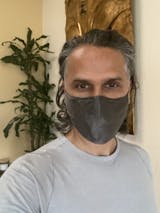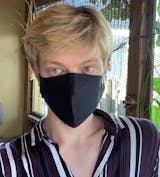You may only think of silk as a luxury fabric, but did you know that silk has been used in the healthcare industry as well? Throughout history, people have loved silk for its smooth and luxurious properties to make clothing, linen, and sustainable silk bedding. But this versatile fiber also lends itself to medical and other technological uses.
In the past decade, there has been a lot of research into the beneficial properties of the material. Silk is antimicrobial, antibacterial, resists mildew and dust mites, and has anti-inflammatory properties! It’s a magical material, for sure. And now the healthcare industry is discovering that manipulating the fibers by applying additives or through bioengineering at the cellular level results in some exciting results. Let’s dig a little into some of silk’s promising possibilities.
Desirable Properties of Silk in Healthcare
Wound dressings, medical implants, and bone support that have no long-term side effects – these are all areas of the medical industry that have grown over the years. Scientists say silk and its derivatives may be able to provide a solution for many of these needs. It’s all thanks to rapid developments in material science and bioengineering.
You see, most silk comes from the silkworm known as Bombyx mori. Bombyx mori silk consists of protein and water. The protein, called fibroin, gives silk a very high load-bearing capacity. That makes it an incredibly strong fabric once woven.
The other protein involved is called sericin, which acts as a gumming agent. Now. for the longest time, in manufacturing commercial silk, the sericin solution was discarded as waste. Now, however, it is a prized raw material for the health, cosmetic, and even electronic industries.
A degumming process using an alkali extracts sericin from the raw silk cocoon. The resulting silk fibroin is dissolved in a salt solution followed by dialysis and finally concentration.
So, with these facts in mind, there are many natural and induced properties of silk that are attractive to the medical field:
- Silk is Antimicrobial
“Antimicrobial” refers to anything that prevents the growth and reproduction of harmful microbes like bacteria and mildew that thrive in warmth and moisture. For example, antimicrobial fabrics are used in wound dressing to prevent infection. Now, one way to make any fabric antimicrobial is by applying an antimicrobial coating on the surface of the fabric.
Another is to introduce antimicrobial agents directly into the fiber.
However, silk has natural antimicrobial properties. Even cooler, though, a team of scientists from the University of Padova in collaboration with the Department of Agriculture and Environment in Italy [1] reported that through genetic modification, the natural antimicrobial characteristic of silk can be increased even further! In their transgenic process, antimicrobial peptides were integrated into the silk proteins with a resulting textile whose properties inhibited bacterial growth of E. coli.
These fabrics are useful in environments where strict protocols about cleanliness and sanitary conditions are a priority.
- Silk can be made Biocompatible
Biomaterials have an important role to play in drug delivery, tissue engineering, immunotherapy, and implants.
In a situation in which someone requires an implant or tissue transplant, one concern is rejection from the body. That’s because when the human body recognizes a foreign object within it, the immune triggers a negative physiological response. Rejection may result in complications ranging from capsular fibrosis to painful inflammation.
Enter silk.
Compared to synthetic materials like polylactic acid, and other natural biomaterials like collagen, one study observed that Bombyx mori silk fibroin performed comparably - and in some instances better - for in-vivo applications [2]. In fact, the brand SERI Surgical Scaffold, described as greater than 95% pure silk fibroin, obtained an FDA clearance in 2008.
- Silk is Biodegradable
As a natural protein polymer, silk fibroin degrades in in-vitro and in-vivo applications due to proteolytic enzymes in the body. This has turned out to have vital implications in the biomedical sector.
In 2018, Scientists from the Indian Institute of Technology in Guwahati, India, and KTH Royal Institute of Technology in Stockholm, Sweden, led by Biman B. Mandal, created skin grafts that can mimic the structure and functions of human skin. Their trick was to make porous sponges using silkworm-silk protein and spider-silk protein. When cultured with specific human skin cells, the sponges formed bilayer skin grafts in three weeks!
“The skin grafts, made of biodegradable silk proteins, can be surgically implanted at a wound site,” says Mandal.
It is no wonder silk is highly sought after for tissue engineering since a second correctional surgery is not required to remove the graft.
- Silk is an Antioxidant
Exposure to cigarette smoke, chemicals in certain cleaners, pollution, and UV radiation, causes free radicals to form in the body. When there is an overabundance of free radicals, the body experiences oxidative stress. Harmful effects include the breakdown of DNA, fatty acids, and proteins which have been linked to inflammation, heart disease, aging, and cancer.
As an antioxidant, sericin can neutralize free radicals.
Sericin is made up of amino acids with hydroxyl groups, which are responsible for its antioxidant characteristics. Flavonoid and phenolic compounds responsible for the cocoon's color also contribute. As a result, the method of extracting sericin influences its antioxidant capabilities. [3]
A study investigated the effect of ultraviolet light B and Hydrogen Peroxide on exposed human primary dermal fibroblast cells. By treating the cells with sericin, the cell viability increased by 30 and 50 % respectively [4]. Also, because it is safe for human consumption, sericin is used as a food preservative and dietary additive [5]
- Silk as an Anti-inflammatory
IL-10 from silk is considered a key player in reducing tissue damage, preventing scars, and restoring or maintaining tissue homeostasis.
You see, the ideal wound dressing provides a healing environment permeable to oxygen and water, is non-toxic and non-immunogenic. Silk has proven to be highly useful in this regard. Scientists found that no inflammatory cytokines were formed when silk fibroin was exposed to peripheral blood mononuclear cells [6]. Rather, the process was able to stimulate interleukin-10, (IL-10), well known for its anti-inflammatory properties.
As a result, silk-based biomaterials have found in-vitro applications, even in patients prone to allergic reactions.
An even more practical use for silk’s anti-inflammatory properties? Organic silk facemasks, silk pillowcases, and sustainable silk bedding that provide relief for people with skin sensitivity and allergy issues!
Promising Silk Materials and Future Use Implications
Routine clinical uses of silk include wound dressings for its antibacterial and antiinflammatory properties, and as silk clothing, to treat atopic dermatitis and other dermatological indications. As an example, some current in-vivo applications of SERI Surgical Scaffold include abdominal wall reconstruction, body contouring, and breast reconstruction.
With emerging technologies, different silk-based materials are being investigated for a wide variety of uses. They include [7]:
- Silk solution as a therapeutic application in treating diabetes
- Silk films for drug delivery and in corneal repair
- Silk scaffolds in fracture fixation devices
- Electrospun silk fibers for ligament replacements and vascular grafts
- Hydrogels for drug delivery and cartilage tissue engineering
- Silk nanoparticles for drug delivery and tumor targeting
- Bioengineered silk for cardiac and muscle tissue repair
The Challenges with Using Silk in Healthcare
Unfortunately, the environment in which silk is produced is prone to variability. Therefore, the manufacturing process requires the strictest controls from sample preparation to testing to get the best of silk’s benefits.
Other researchers are interpreting property variability as silk’s responsiveness to its environment. As such, they are looking to exploit this characteristic and produce so-called smart silk materials.
Additionally, extrapolating existing materials to new applications or matching entirely new materials to applications needs rigorous testing before clinical approval. Adding to the complexity of new applications is juggling the composition of sericin and fibroin. For example, in an investigation, silk sutures with some sericin coating produced adverse reactions in a patient, and yet, sericin showed low allergenic responses on its own [8]
Although silk material production is straightforward, the high purity requirements for medical use introduces additional costs. However, compared to many synthetics and other natural polymers, namely collagen, silk is a much cheaper alternative. Collagen is often derived from human cadavers that may carry pathogens and diseases. Removing all traces of contamination increases the production cost of high-purity collagen.
The endless possibilities of Silk
At various stages of silk fabrication, it is possible to obtain different desirable qualities. On top of that, by combining silk with other types of fibers, researchers can explore new silk hybrid materials with a spectrum of properties to play with. When you consider that silk is a sustainable material, the possibilities are only a function of the imagination.
How to Find Sustainable Silk Bedding
If you’re looking for sustainable silk bedding, pillowcases, or face masks of your own, shop www.FaitavecCoeur.com. When you buy from Fait avec Coeur, you are buying certified organic silk, traceable and ethically sourced, and free of harmful chemicals.
All of Fait avec Coeur's silk products are OEKO-TEX®, BSCI, and ISO certified.
Sources
[1] https://link.springer.com/article/10.1007/s11248-018-0059-0
[2] https://pubmed.ncbi.nlm.nih.gov/26322725/
[3] https://iubmb.onlinelibrary.wiley.com/doi/abs/10.1042/BA20090186
[4] https://link.springer.com/article/10.1007%2Fs11010-008-9702-z
[5] https://www.researchgate.net/publication/325087249_Sericin_a_dietary_additive_Mini_review
[6] https://www.sciencedirect.com/science/article/abs/pii/S2352492820303226
[7] https://onlinelibrary.wiley.com/doi/10.1002/adhm.201800465
[8] https://onlinelibrary.wiley.com/doi/10.1002/mabi.201700229










